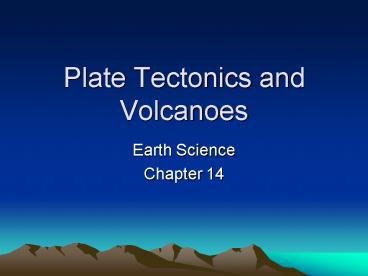Plate Tectonics and Volcanoes - PowerPoint PPT Presentation
1 / 30
Title:
Plate Tectonics and Volcanoes
Description:
Volcanoes. Composite Cone. Alternating layer of lava and cinders (ash) ... Chain of volcanoes called an island arc. Ocean/Continent. Volcanic arc ... – PowerPoint PPT presentation
Number of Views:770
Avg rating:3.0/5.0
Title: Plate Tectonics and Volcanoes
1
Plate Tectonics and Volcanoes
- Earth Science
- Chapter 14
2
Volcanoes
- Volcanoes
- Hills or mountains made from hardened magma
3
Volcanoes
- Magma
- Molten rock that is below the surface of the
earth - Located in the mantle
- Forms when rocks melt due to subduction
- Lava
- Molten rock that has reached the surface of the
earth - Forms when volcanoes erupt
4
Volcanoes
- Magma/lava is made of
- Silica
- Water vapor
- Magnesium
- Iron
5
Volcanoes
- 3 Types of magma/lava
- Felsic (Rhyolitic)
- Made of 60 or more silica
- Intermediate (Andesitic)
- Made of 50-60 silica
- Mafic (Basaltic)
- Made of 50 or less silica
6
Volcanoes
- Properties of Felsic (Rhyolitic) magma
- Light in color
- High silica (SiO2) content
- Contains a lot of water vapor
- Does not flow easily
- Highly viscous (thick)
- Often solidifies before reaching the earths
surface - High amount of gases (bubbles stuck in thick
liquid)
7
Volcanoes
- Properties of Mafic (Basaltic) magma
- Dark in color
- High in iron
- Low silica content
- Flows easily
- Does not contain a lot of water vapor
- Low amount of gases (bubbles escape easily)
8
Mafic Lava
9
Volcanoes
- 2 Manners of Eruptions
- 1. Pyroclastic
- Highly explosive
- Felsic lava (trapped gases build up pressure)
- Lots of poisonous gases and tephra, little magma
erupted - Pyroclastic flow hot stream of gases and tephra
that flows down the volcano
10
Volcanoes
- Types of Tephra
- Bombs
- Extremely large ( 64 mm) chunks erupted from
volcano - Ejected as liquid, harden as they fall
- Blocks
- Erupted as solid pieces ( 64 mm)
- Lapilli
- Smaller than bombs ( up to 64 mm)
- Ash
- Fine grained/very small chunks (
11
Volcanoes
- 2. Non-Pyroclastic
- Non-explosive
- Mafic lava (very little trapped gases)
- Lava erupts more continuously, but flows out
quietly - Mid-Atlantic Ridge is best example
12
Volcanoes
- 3 Types of Volcanoes
- Shield cone
- Broad or wide
- Mafic lava
- Mellow eruptions
- Hawaii (caused by a hot spot)
13
Shield Cone
14
Volcanoes
- Cinder cone
- Narrow
- Tall (not as tall as composites)
- Felsic lava
- Pyroclastic eruptions
- Lots of tephra and gases, not much lava
- Paricutin, Mexico
15
Cinder Cone
16
Volcanoes
- Composite Cone
- Alternating layer of lava and cinders (ash)
- Alternates pyroclastic and non-pyroclastic
eruptions - Tall, snow-capped peaks
- Mount St. Helens
17
Composite Cone
18
Volcanoes and Boundaries
- Subduction Boundaries
- Pyroclastic eruptions
- Felsic lava
- Slabs are pushed down into the mantle
- Pressure and temp rise - gets rid of water as
steam - Hot Fluids melt mantle rock magma migrates
upward. - Cinder and composite cones have pyroclastic
eruptions
19
Ring of Fire
20
Volcanoes and Boundaries
- Subduction Volcanoes
- Ocean/Ocean
- Chain of volcanoes called an island arc
- Ocean/Continent
- Volcanic arc
- Continental crust has higher silica content
- Magma varies in composition (what its made of)
21
Volcanoes and Boundaries
- Subduction Volcanoes
22
Volcanoes and Boundaries
- Divergent Boundary
- Non-pyroclastic
- Mafic lava
- Magma produced during sea floor spreading
- Magma rises to fill in rift where plates have
separated - Sometimes called basaltic (most of the sea floor
is made of basalt)
23
Volcanoes and Boundaries
- Big Idea
- Plate motions provide the mechanism by which
mantle rocks melt to generate magma.
24
Volcanic Structures
- There is much more magma under the surface of the
Earth than we see with volcanoes. - That magma forms other volcanic structures
(plutons) that we can identify. - It solidifies in the Earths crust, hardening in
other rocks.
25
Volcanic Structures
- Types
- Batholiths
- Hardened magma that forms the cores of many
mountain ranges - Largest type of intrusion
- Sometimes exposed at the surface due to erosion
26
Volcanic Structures
- Stock
- Hardened magma exposed at the surface due to
erosion - Small batholith
27
Volcanic Structures
- Dike
- Magma cools inside a fracture
- A fracture is a break in the crust with no
movement - Cuts vertically across the layers of rock
28
Volcanic Structures
- Sill
- Magma goes into rock layers horizontally and
hardens
29
Volcanic Structures
- Laccolith
- Goes into layers horizontally, but the stiff
magma is unable to spread to form a sill - Instead it pushes the land up to form a dome
30
Volcanic Structures
- Volcanic Neck
- Plug of hardened magma left in the vent
- Cone is completely eroded































